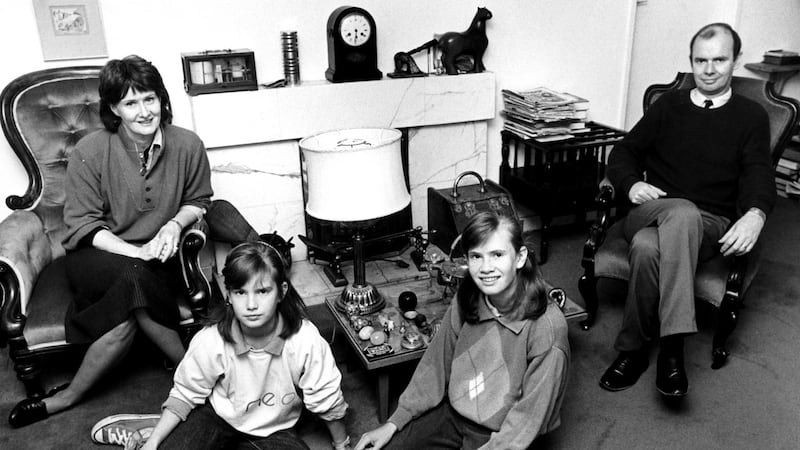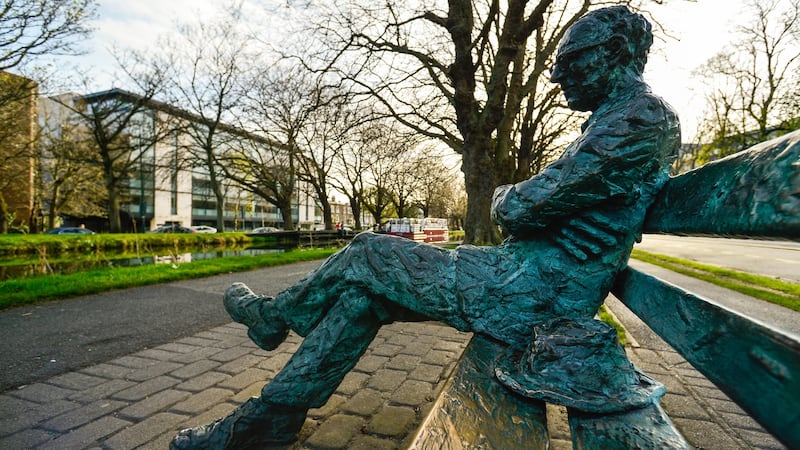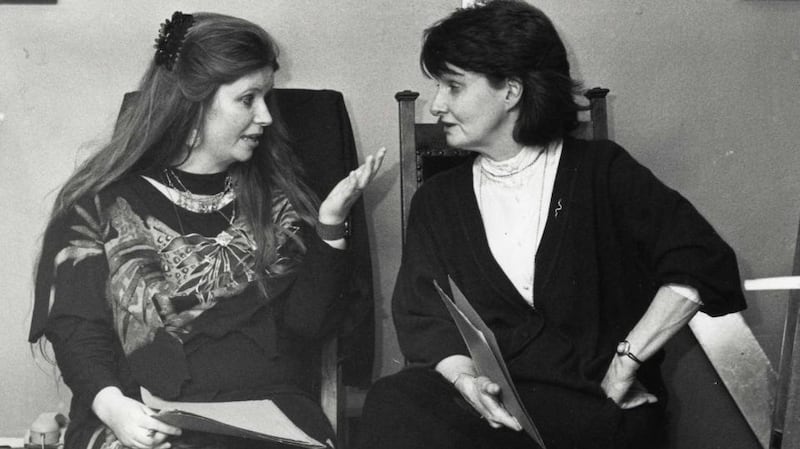Fable has it that Guy de Maupassant lunched every day in the Eiffel Tower restaurant as it was the only place in Paris he did not have to see it. Irish writers have a similar fixation with place. Amongst others, Edna O’Brien and James Joyce breathed easier in less prescriptive climes than Catholic Ireland, but instead of extinguishing their view of it they sharpened it.
Eavan Boland’s work was less concerned with visibility and more with what fell outside of it. Given that the margins of a national literature are often narrow, this was a complicated concern for a female writer in the 1960s, seeking to place the reality of her life within Irish literature. Not only was Irish poetry perceived as a male enterprise due to the publishing landscape, but the literary culture Boland entered when she was published in The Irish Times aged 20 was a male-dominated pub scene.
As Boland writes in Object Lessons: “The poet’s vocation – or the historical construction put upon it – is one of the most problematic areas for any woman who comes to the craft. Not only has it been defined by a tradition which could never foresee her, but it is construed by men about men.”

This marked territory extended not only to literary but civic space. Even now, despite its diversity, the “official” face of Irish literature remains white and male, evidenced in the naming of streets, squares, ships and statues. It exists within literature’s colonialisation of place and commerce’s colonisation of literature. One need not walk far in Dublin to encounter Joyce’s glasses and cane or Oscar Wilde’s languishing lean. To mention the Grand Canal is to conjure Patrick Kavanagh. Born near the canal on Hatch Street in 1944, Boland also reimagined Dublin and the Grand Canal in poetry and prose. Yet there is no public shorthand nor visible commemoration to attest to her contribution.
Female achievement
Until her death last year, such a commemoration might have been unnecessary but the dearth of monuments to female achievement indicates the continued challenges to female visibility within “official Ireland” and reminds us of Boland’s own struggle against “the flawed permissions which surround the inherited Irish poem, in which you could have a political murder, but not a baby, a line of hills but not the suburbs under them”. Consider the frequency with which Irish government officials reference poets such as Seamus Heaney and Derek Mahon in their national addresses, granting further legitimacy and visibility to the already visible and “legitimate”.
In her inaugural speech as Ireland’s first female president, Mary Robinson’s referencing of Boland’s poem The Singers was a definitive moment for women politically and poetically. But even now the repetition of the same official selections act as endorsements of literary voices, which impact on literary legacy and cultural politics. Such references factor into the lore and identity of a country. As Boland noted: “A society, a nation, a literary heritage are always in danger of making up their communicable heritage from their visible elements.”
That the cityscape has changed little since Boland was seventeen, working in a hotel before attending Trinity College, testifies to this continued bias: “Whatever time of the day it was, they were there too: the iron fathers of the city. Grattan. O’ Connell. Parnell. Huge statues… Standing over their statements, their promises. Looking up at them every morning, I felt like… what I would always be: a daughter.” In reinforcing the societal hierarchies of the 1960s and earlier, the cityscape suggested women as being outside history just as it does today.
But Boland’s sense of belonging was complicated earlier. Alongside her mother, the expressionist painter Frances Kelly, aged six Boland relocated to London when her father Frederick became Irish ambassador to the UK. “Hardly anything else that happened to me as a child was as important as this: that I left one country and came to another. That an ordinary displacement made an extraordinary distance between the word ‘place’ and the word ‘mine’.”

Seeking an identity, Boland clung to uncertain memories of her Dublin childhood: “I would remember the unkempt greenness of the canal where it divided Leeson Street. The lock was made of splintery wood, and boys dived from its narrow platform in summer.” Yet Boland’s recollections of Ireland clashed with its mythology. Discovering a book of legends in her playroom, Boland sensed the discrepancy between Ireland’s constructed identity and its reality: “There was a woman sitting on a throne holding a harp… ‘Hibernia’, it said under the picture. And... ‘O Harp of my country’. I was confused[...] Was this the place I had heard of? Was this what it offered? [...] I thought about it. No one I knew used one.”
Nevertheless, Boland too began to mythologise her origins in a bid to belong. The returned exile, then aged 14, was also displaced in Dublin. “As I learned these things[...]I began to watch places with an interest so exact it might have been a memory. There was that small newsagent which sold honeycomb toffee in summer. I could imagine myself there, a child of nine, buying peppermints and walking back down the canal. It became a powerful reconstruction of a childhood which had never happened.”
Establish her place
It is fitting then that aged 19 in a flat near the Grand Canal, Boland began to establish her place. “For me, as for so many other writers in so many other rooms, this particular one remains a place of origin.” Here, attempting every day “to write someone else’s poem,” Boland confronted the constraints of mythology, the traps of visibility. “Why do you go back to that attic flat, night after night, to write forms explored by Englishmen hundreds of years ago? You are Irish. You are a woman. Why do you keep these things at the periphery of the poem? Why do you not move them to the centre, where they belong?”
Poetry at the time did not preclude women’s visibility completely but diminished it. Literary revival figures like dark Rosaleen and Cathleen Ni Houlihan may have suggested the Irish nation as woman but relegated women’s existence to metaphor and muse. Such symbolism suggested women’s inclusion was determined by her serviceability to man and nation, rather than on the fact of her existence. If women were to be visible they were not entitled, they must work to earn that place.
In entering into a dialogue with the politics of place, place spoke back. Boland recalls: “I was slowly, after so many disappointments, beginning to find myself in place. Gradually the city was catching my attention. Not far from my flat was the canal[...]Patrick Kavanagh had come here in the mid-fifties [and] had written a visionary sonnet. I never passed the canal at that point without thinking of it. O commemorate me where there is water. There was something so downright and local about the poem that it opened out the idea of place as something language could claim even if ownership had been denied.”

Partly due to his statue, Kavanagh is now the writer most synonymous with this area of Dublin, a city and literary tradition he too struggled for entry into. Although a beloved example of public art, Kavanagh’s laissez-faire slouch belies his struggle for belonging and transforms him, as Boland once observed in a statue of Robert Emmet, “from action to image”. There is, as Boland wrote, a “recurring temptation for any nation, and for any writer who operates within its field of force, to make an ornament of the past, to turn the losses to victories and to restate humiliations as truths”. In many ways the mythology of Kavanagh looms larger than his life.
Right to belong
Boland’s quest was to make her life visible in poetry, to establish her right to belong and to expose the constraints of belonging. She beseeches us not to make an ornament of the past. So on the first anniversary of Boland’s death, the question should not be whether we commemorate her achievements, but how we acknowledge the reality of her life.
In her poem Escape, set on the Grand Canal, Boland is both the subject and object; both herself as the young poet struggling to find her voice and the established poet she would become. Rather than a singular image, the protagonist is the space between these figures; between mythology and reality, between belonging and not belonging. Boland came to acknowledge that “marginality within a tradition, however painful, confers certain advantages. It allows the writer clear eyes and a quick critical sense [...] the real potential of subversion.” To truly belong, one must contemplate what it is not to belong.

Though it would be the city suburb of Dundrum where Boland would establish her life within her work, the Grand Canal bank is a fitting location to remember that struggle. A fluid rather than fixed place between her past and future. It was here, Boland came “to find courage in the way this dawn moves slowly down the canal”.
That Boland, a white middle-class woman with the cultural networks afforded by her upbringing, should document her own marginality highlights the greater challenges to writers without such privilege. Boland’s later accolades as a poet did not stop her advocacy of marginalised voices through her mentoring and editorships. She publicly criticised the exclusion of women writers in the 1991 Field Day Anthology of Irish Writing, which “disfigured the national literature”, though her own poems were included. While visibly marking Boland’s legacy might begin to redress women’s invisibility in the city, as Sappho suggested: “Although only breath, words I command are immortal.” A lasting acknowledgement of Boland and Irish female literary heritage is to read, reference and mark her words. #markherwords
Louisa Carroll is an Irish Research Council doctoral scholar at University College Dublin’s school of English and resident scholar at UCD Humanities Institute. Her research and cultural projects examine the relationship between the Grand Canal and Irish literature. Twitter:@canalwriters












